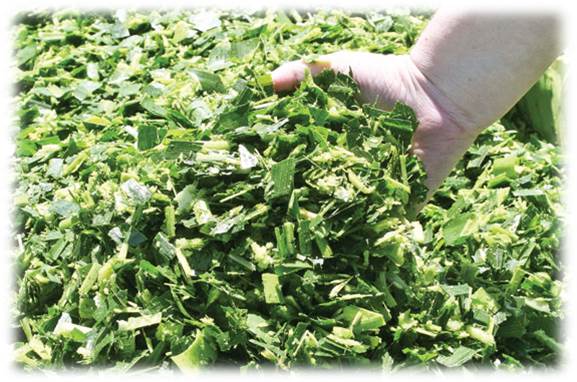Corn Silage :
Silage is a type of fodder made from green foliage crops which have been preserved by acidification, achieved through fermentation. It can be fed to cattle, sheep and other such cud-chewing animals. The fermentation and storage process is called ensilage and is usually made from grass crops, including maize, legumes, sorghum or other cereals, using the entire green plant. Silage can be made from many field crops.
Corn silage is a high-quality forage crop that is preserved by anaerobic fermentation. This process uses bacteria to convert soluble carbohydrates into acetic and lactic acid, which “pickles” the crop.
Corn Silage is important for improved cow nutrition, it is safe to feed because it contains a mix of grain and fiber.
Corn Silage can be used to increase livestock growth rates, improve overall health of the cattle and maximize milk production.


Dehydrated Corn Silage
What is the main challenge?
The challenge is to convert the Corn silage into pellets. We can achieve it by the following processes:-
Particle Size Reduction- We have 65% moisture Silage, before baling the particle size needs to be reduced to 9mm-13mm. After baling it becomes 60% silage.
Baling is the process of wrapping compacted and inoculated grass in polypropylene sheets. The sheets should provide an airtight environment for the silage so that the fermentation of the grass occurs without oxygen. When the bale comes out, it is automatically stretch wrapped in baling system. This bailing time has 8 hours window for decomposition. The procurement time would be approx. 40 days
Fermentation - In the baling condition you can ferment it. The preservation of the forage crops as silage is based on a fermentation process that lowers the pH and preserves the nutritive value of the fresh crop. This process takes about 21 days.
After the period of Fermentation, we cut open the bale and we pass the material through a customized equipment to reduce the moisture.
And if required, we do sun drying/roasting with a dryer to reduce moisture to 15%.
Finally, Pelletization - 15% is suitable for pelleting. It should be packed in laminated moisture proof bags.
Dehydrated Corn Silage Pellets
It’s a twin process, the final moisture in the bale is approx. 60%. In final pellets moisture is about 10-12%, therefore with 60% silage moisture , the net moisture reduction is almost 50%.
For an illustration, if we take 12000 tons of baled silage, we can expect pellets of half amount or 6000 tons per annum or about 20 tons per day (300 working days).
Ratio of pellets to the wet silage is 1/3 i.e. 1:3.
In terms of fodder its equivalent to 12000 tons of fodder, adding water to the pellets would make it 12000 tons again.
Overall Advantages of Dehydrated Corn Silage Pellets



